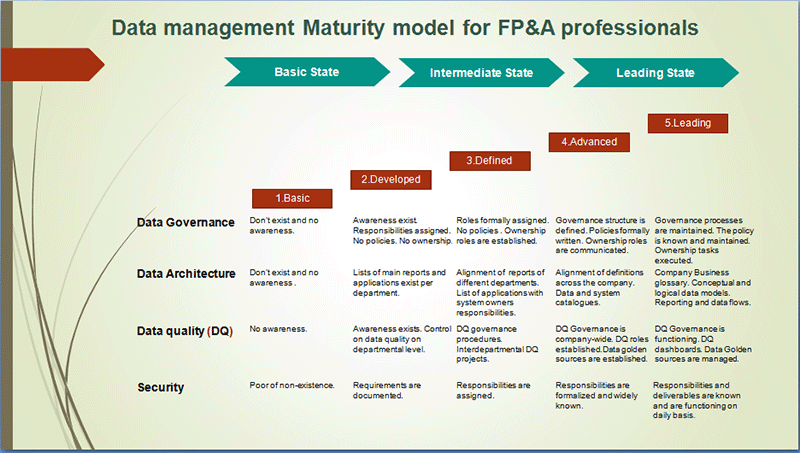Even if last six years I have been specialized in Data management, I still follow (thanks...
 As promised in the previous article, let us go deeper into the relationship between FP&A and Data management (DM) and see how Data management enriches your FP&A role and successes. Using the FP&A Analytics Maturity Model, that was developed by London FP&A Board, you have definitely checked, which state of the FP&A maturity corresponds to your company and which goals are to be reached in the nearest future.
As promised in the previous article, let us go deeper into the relationship between FP&A and Data management (DM) and see how Data management enriches your FP&A role and successes. Using the FP&A Analytics Maturity Model, that was developed by London FP&A Board, you have definitely checked, which state of the FP&A maturity corresponds to your company and which goals are to be reached in the nearest future.
Let’s now check:
- Which elements of DM touch your daily work
- How to measure DM maturity in the frame of the FP&A maturity model.
Before we continue with a definition of Data management, let me ask you three questions:
- Do you have a situation that at least 40-50% of your reports are made in Excel?
- Do you have the reconciliation problems between different reports?
- Do you need to ask for some input information from your colleagues from other departments?
If all answers are ‘YES’, then it means that you already deal with Data management on a daily basis and there is a reason for you to continue reading the article.
As discussed in the article (1), you as FP&A professional deal with company value. Data is also a company asset and to be treated and to be managed as assets.
What are the main elements of Data management which might be of your interest and require your attention?
- Data governance rules and procedures that allow you to solve data-related issues with other departments
- Data architecture gives answers on your questions: which data do I have, what the data means, where data is located, and how it streams from a source to the report along with different systems and departments
- Data quality deals with the assessment of whether data you get from your reports is an acceptable level of accuracy and completeness. Do you receive it on time?
- DWH/BI provides you with reporting and historical and analysis capabilities
- Security ensures that all your data is classified.
These are not all established Data management elements, but if you are in control of these five elements for your data, you safeguard an outstanding quality of your FP&A work results.
In order to define the maturity, you need to know, which deliverables of each DM areas are to be measured. So, let’s make a short list of the main deliverables. The main deliverables can be briefly described as follows:
Data governance is measured by the presence of a Governance Policy, roles, and/or procedures that describe who is responsible for what in regards to solving data-related issues among different departments;
Data architecture is measured by:
- Company business glossary – the list of terminology that eases communications and aligns ‘local languages’ of different departments
- Catalog of reports and/or data elements – the list of reports used within a company with at least some information regarding it: who makes the reports, who are recipients, etc.
- Catalog of software applications used – the list of applications used across the company and their owners
Data quality practices include:
- Data quality requirements – do we know what kind of controls are needed to ensure accurate and complete data?
- Data quality internal projects – are there some running projects across the company that aims to solve possible data quality issues?
- Data quality dashboard is the tooling to monitor on a daily basis quality of data in order to undertake actions.
DWH/BI is measured by the availability of tooling for report generating and for the dissemination of reports.
Data security can be assessed by the presence of policies and procedures, data classifications, monitoring and issue resolution mechanisms.
Let’s now to combine these areas with FP&A maturity model (see the picture below).
Thanks in advance if you let us know, at which stage of the Maturity level you will put your company.

Subscribe to
FP&A Trends Digest

We will regularly update you on the latest trends and developments in FP&A. Take the opportunity to have articles written by finance thought leaders delivered directly to your inbox; watch compelling webinars; connect with like-minded professionals; and become a part of our global community.


